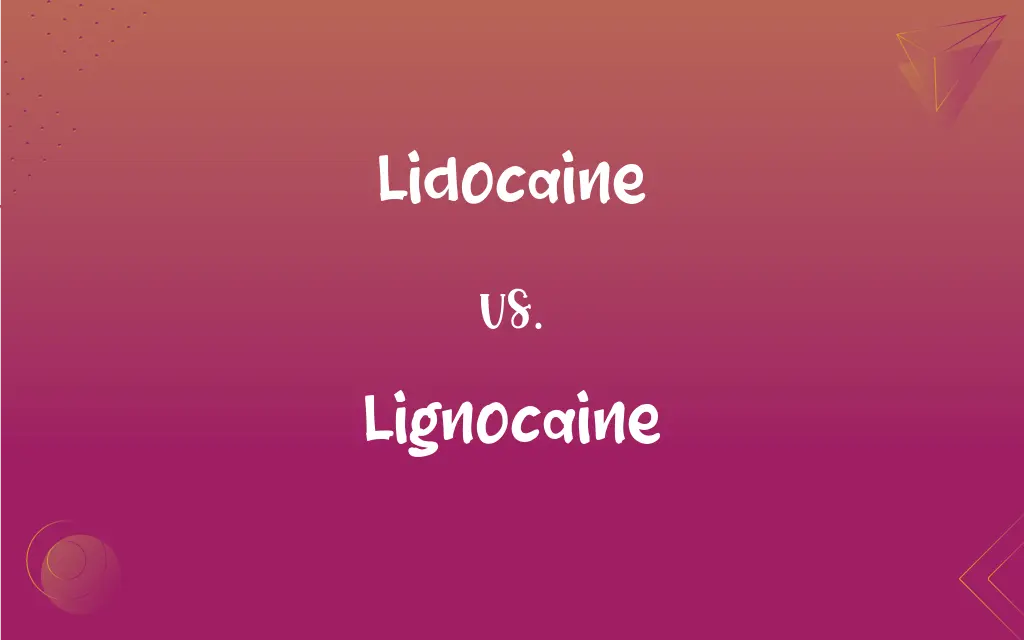Lidocaine vs. Lignocaine: What's the Difference?
Edited by Aimie Carlson || By Janet White || Published on January 26, 2024
Lidocaine and lignocaine are the same local anesthetic and antiarrhythmic medication, known as lidocaine in the US and lignocaine in other countries.

Key Differences
Lidocaine, known as lignocaine in many parts of the world, is a medication used to numb tissue in a specific area. It's used in minor surgical procedures as a local anesthetic. Lignocaine, another name for the same chemical, is widely recognized in the UK and other countries. Both terms refer to the same drug with the same medical properties and uses.
The drug lidocaine/lignocaine is classified as an amide-type local anesthetic. Lidocaine is the term predominantly used in the United States. In contrast, lignocaine is commonly used in many other English-speaking countries. Despite the different names, the compound's chemical structure and action remain the same.
Lidocaine is also used in medical settings as an antiarrhythmic agent, particularly in the treatment of heart arrhythmias. Similarly, lignocaine serves the same purpose in countries where this nomenclature is adopted. The efficacy and side effects of lidocaine and lignocaine are identical, as they are simply different names for the same medication.
In the context of dentistry, lidocaine is a common local anesthetic used for procedures like tooth extractions or filling cavities. As lignocaine, it serves the same role in dental practices outside the US. Both forms are known for their rapid onset and relatively short duration of action.
Lidocaine is also available in various forms, including injectable solutions and topical preparations. Lignocaine, under its different name, is used in the same forms and concentrations. The choice of name depends on the regional linguistic preferences but does not imply any difference in formulation or application.
ADVERTISEMENT
Comparison Chart
Name Usage
Predominantly in the United States
Common in the UK and other countries
Chemical Structure
Identical to lignocaine
Identical to lidocaine
Medical Use
Local anesthetic, antiarrhythmic agent
Local anesthetic, antiarrhythmic agent
Application in Dentistry
Used for numbing during dental procedures
Same as lidocaine
Available Forms
Injectable solutions, topical preparations
Same as lidocaine
ADVERTISEMENT
Lidocaine and Lignocaine Definitions
Lidocaine
A local anesthetic used in minor surgeries to numb a specific area.
Lidocaine was applied to numb the skin before the procedure.
Lignocaine
An anesthetic used to temporarily numb specific body areas during minor surgeries.
Lignocaine was applied to the patient's skin before stitching the wound.
Lidocaine
A medication used as an antiarrhythmic agent in heart conditions.
Lidocaine was administered to treat the patient's arrhythmia.
Lignocaine
Frequently used in dental practices for painless procedures.
Lignocaine was administered before the dental filling.
Lidocaine
An amide-type local anesthetic known for rapid onset.
Lidocaine acted quickly to numb the surgical area.
Lignocaine
A rapid-action local anesthetic in the amide group.
The lignocaine quickly numbed the area for the biopsy.
Lidocaine
Available in various forms such as injectable and topical.
The doctor used lidocaine gel to numb the gums.
Lignocaine
A drug used for treating certain types of heart arrhythmias.
Lignocaine effectively stabilized the patient's heartbeat.
Lidocaine
Commonly used in dentistry for procedures like tooth extractions.
Lidocaine ensured the patient felt no pain during the extraction.
Lignocaine
Available in different forms, including creams and injections.
The dentist used lignocaine injection for the root canal treatment.
Lidocaine
A synthetic amide, C14H22N2O, used chiefly in the form of its hydrochloride as a local anesthetic and antiarrhythmic agent.
Lignocaine
(pharmaceutical drug) lidocaine.
Lidocaine
(pharmaceutical drug) A crystalline compound C14H22N2O that is used in the form of its hydrochloride as a local anesthetic and as an antiarrhythmic agent.
Lidocaine
A local anesthetic (trade names Lidocaine and Xylocaine) used topically on the skin and mucous membranes
FAQs
Is lignocaine the same as lidocaine?
Yes, lignocaine is another name for lidocaine.
What is lidocaine used for?
Lidocaine is used as a local anesthetic and an antiarrhythmic agent.
What's the onset time for lidocaine's effect?
Lidocaine typically has a rapid onset.
Can lidocaine be used for heart conditions?
Yes, it's used as an antiarrhythmic agent for heart arrhythmias.
How does lignocaine work?
It works by numbing specific areas, blocking pain signals.
Are there any side effects of lignocaine?
Yes, like any medication, it can have side effects.
Is lignocaine safe for dental procedures?
Yes, it's commonly used in dentistry for painless procedures.
Can lignocaine be used on all skin types?
Generally, yes, but patch testing is recommended for sensitive skin.
What forms does lidocaine come in?
It's available in injectable solutions and topical forms.
Why are there two names for the same drug?
The different names are due to regional linguistic preferences.
Can lidocaine be used for chronic pain management?
It's more commonly used for acute pain and procedural anesthesia.
Is lignocaine available over the counter?
It depends on the country and the form of the drug.
Can lidocaine be used for children?
Yes, but under appropriate medical supervision.
How long do the effects of lidocaine last?
The effects usually last for a short duration.
Does lignocaine interact with other medications?
Yes, it can interact with certain other drugs.
What precautions should be taken when using lignocaine?
Follow medical advice, especially regarding dosage and allergies.
How is lidocaine administered for heart conditions?
It's typically administered intravenously in such cases.
Is lidocaine effective for all dental procedures?
It's effective for most, but not all, depending on the procedure.
Is lignocaine effective in treating all types of arrhythmias?
It's effective for certain types, but not all.
How should lidocaine be stored?
It should be stored at room temperature, away from light and moisture.
About Author
Written by
Janet WhiteJanet White has been an esteemed writer and blogger for Difference Wiki. Holding a Master's degree in Science and Medical Journalism from the prestigious Boston University, she has consistently demonstrated her expertise and passion for her field. When she's not immersed in her work, Janet relishes her time exercising, delving into a good book, and cherishing moments with friends and family.
Edited by
Aimie CarlsonAimie Carlson, holding a master's degree in English literature, is a fervent English language enthusiast. She lends her writing talents to Difference Wiki, a prominent website that specializes in comparisons, offering readers insightful analyses that both captivate and inform.































































